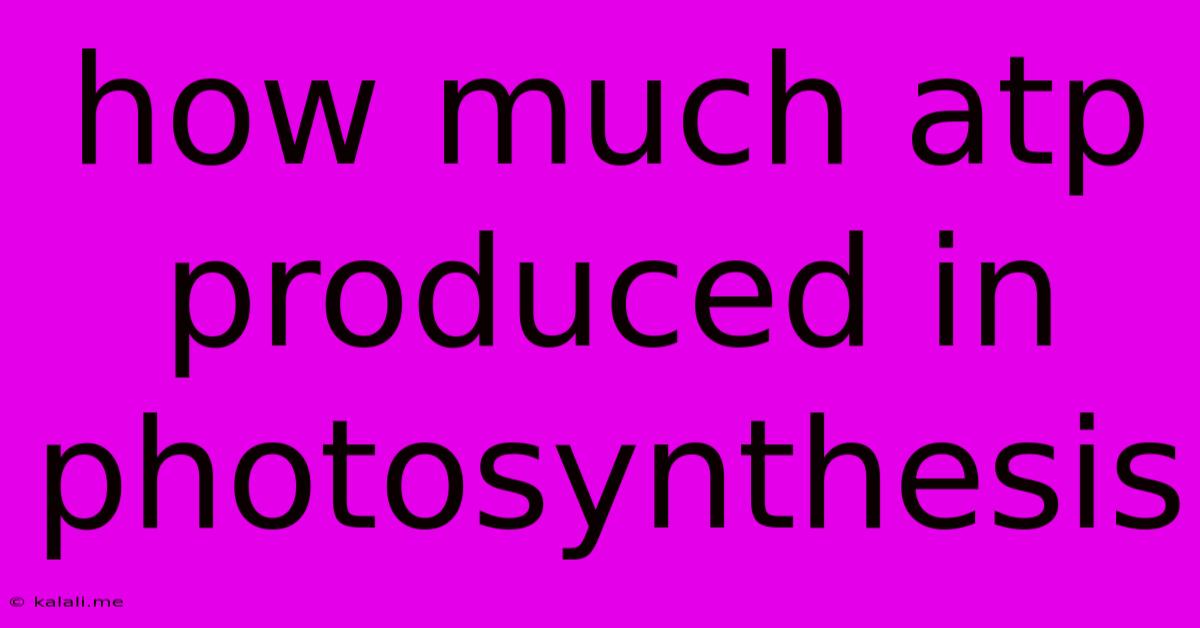How Much Atp Produced In Photosynthesis
Kalali
Jun 16, 2025 · 3 min read

Table of Contents
How Much ATP is Produced in Photosynthesis? A Closer Look at the Energy Currency of Plants
Photosynthesis, the remarkable process by which plants convert sunlight into chemical energy, is vital for life on Earth. A crucial aspect of this process is the production of ATP (adenosine triphosphate), the cell's primary energy currency. But exactly how much ATP is produced during photosynthesis is a question with a nuanced answer. It's not a fixed number, but rather depends on several factors and the specific pathways involved. This article will delve into the complexities of ATP production in photosynthesis, exploring both the light-dependent and light-independent reactions.
Understanding the Two Stages of Photosynthesis
Photosynthesis is broadly divided into two stages: the light-dependent reactions and the light-independent reactions (Calvin cycle). Both contribute to ATP generation, but through different mechanisms.
The Light-Dependent Reactions: Powering the Process
The light-dependent reactions occur in the thylakoid membranes within chloroplasts. Here, light energy is absorbed by chlorophyll and other pigments, initiating a chain of events that ultimately leads to ATP synthesis. This process involves:
- Photosystem II (PSII): Light energy excites electrons in chlorophyll, leading to water splitting (photolysis), releasing oxygen as a byproduct. These energized electrons are passed along an electron transport chain.
- Electron Transport Chain: As electrons move down the chain, energy is released and used to pump protons (H+) into the thylakoid lumen, creating a proton gradient.
- Photosystem I (PSI): Electrons reach PSI, where they are further energized by light and passed to ferredoxin (Fd).
- ATP Synthase: The proton gradient generated across the thylakoid membrane drives ATP synthesis through chemiosmosis. Protons flow back into the stroma through ATP synthase, an enzyme that uses this energy to phosphorylate ADP, producing ATP. This is photophosphorylation.
The exact number of ATP molecules produced per photon absorbed in the light-dependent reactions is difficult to pinpoint precisely due to variations in efficiency and different photosynthetic organisms. However, it's generally understood that a significant amount of ATP is generated, providing the energy needed for the subsequent Calvin cycle.
The Light-Independent Reactions (Calvin Cycle): Building the Sugars
The light-independent reactions, or Calvin cycle, take place in the stroma of the chloroplast. This is where the ATP generated in the light-dependent reactions is utilized. The Calvin cycle uses CO2 from the atmosphere, along with ATP and NADPH (another energy carrier produced in the light-dependent reactions), to synthesize glucose and other organic molecules.
- Carbon Fixation: CO2 is incorporated into RuBP (ribulose-1,5-bisphosphate), a five-carbon sugar, catalyzed by the enzyme RuBisCO.
- Reduction: The resulting 3-carbon molecules are reduced using ATP and NADPH, ultimately forming glyceraldehyde-3-phosphate (G3P), a precursor to glucose.
- Regeneration: Some G3P is used to regenerate RuBP, ensuring the cycle continues.
While the Calvin cycle doesn't directly produce ATP, it consumes a significant amount of the ATP generated in the light-dependent reactions to power the energy-requiring steps of sugar synthesis. Therefore, the ATP production in the light-dependent reactions is indirectly responsible for the successful completion of the Calvin cycle.
The Bottom Line: No Single Answer
There isn't a single, definitive answer to the question of how much ATP is produced in photosynthesis. The amount varies based on several factors including:
- Light intensity: Higher light intensity generally leads to greater ATP production.
- CO2 concentration: Adequate CO2 is essential for the Calvin cycle, which indirectly affects ATP consumption.
- Temperature: Optimal temperature ranges are necessary for enzyme activity.
- Plant species: Different plants have varying photosynthetic efficiencies.
Instead of focusing on a specific number, it's more accurate to understand that photosynthesis generates a substantial amount of ATP in the light-dependent reactions, which is then utilized in the light-independent reactions to fuel the synthesis of glucose and other vital organic compounds. The efficiency and precise quantity of ATP produced are dynamic and dependent on the environmental conditions and the specific photosynthetic machinery of the plant.
Latest Posts
Latest Posts
-
The Study Of The Earth Is Called
Jun 16, 2025
-
What Is The Least Common Multiple Of 26 And 39
Jun 16, 2025
-
Which Of The Following Is Chemical Change
Jun 16, 2025
-
Atoms Of The Same Element Having Different Numbers Of Neutrons
Jun 16, 2025
-
Displacement Thickness In Boundary Layer Formula
Jun 16, 2025
Related Post
Thank you for visiting our website which covers about How Much Atp Produced In Photosynthesis . We hope the information provided has been useful to you. Feel free to contact us if you have any questions or need further assistance. See you next time and don't miss to bookmark.